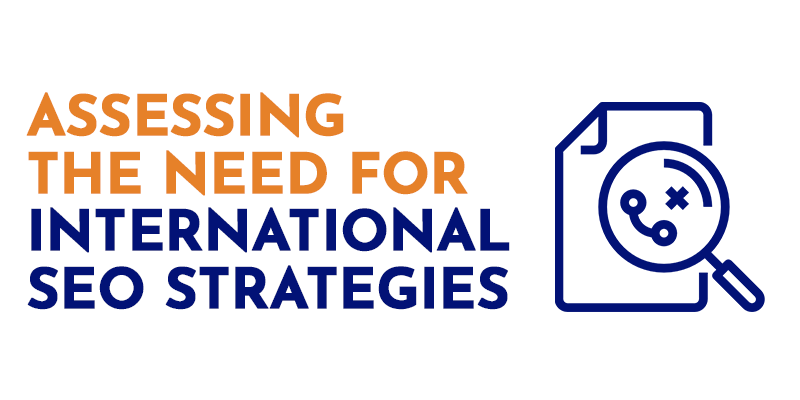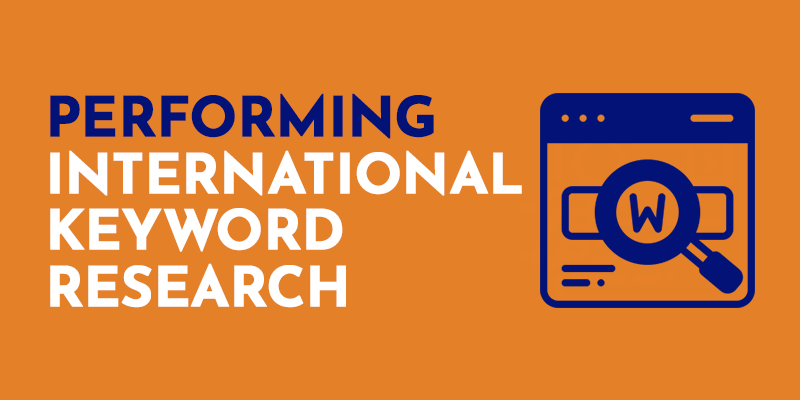In a world where digital borders are increasingly blurred, the growth of international markets presents a golden opportunity for businesses to expand their reach. Yet, more than merely translating content is needed; the nuances of international SEO can determine a brand’s success on the global stage. As consumers become more diverse, so does the competitive landscape, requiring brands to optimize their websites effectively to cater to international audiences.
This article will delve into the essential steps for optimizing your website for international SEO, offering insights on market analysis, content localization, and tools for measuring success. By implementing these strategies, you can embrace the global digital market and ensure your brand resonates with diverse audiences worldwide.
Assessing the Need for International SEO Strategies
 Optimizing your website for international SEO is crucial for businesses tapping into global markets. Begin by assessing whether your business goals align with expanding your online presence to international audiences. Consider factors such as potential organic traffic from target countries and the search volume for relevant keywords in those regions. Utilize tools like Google Analytics to analyze traffic sources and identify where international SEO efforts can deliver the highest conversion rates.
Optimizing your website for international SEO is crucial for businesses tapping into global markets. Begin by assessing whether your business goals align with expanding your online presence to international audiences. Consider factors such as potential organic traffic from target countries and the search volume for relevant keywords in those regions. Utilize tools like Google Analytics to analyze traffic sources and identify where international SEO efforts can deliver the highest conversion rates.
Next, evaluate the linguistic and cultural differences of your target market. Determine the target language and assess if the content should be tailored for native speakers using native language or translated with precision. This step is essential to avoid creating duplicate content and to enhance your site’s search ranking. Consider using country-specific or country-code top-level domains to improve your visibility in specific international markets.
To guide your international SEO strategy, utilize keyword research tools to find relevant keywords with high search volumes in each target country. Consider domain authority, URL structure, and whether to employ a single domain with subdirectories or Generic Top-Level Domains for global reach. Implementing these strategies effectively can significantly enhance your international SEO success.
Conducting Market Analysis

Market analysis is essential for understanding your target market and making informed business decisions. Identify your target audience and examine their preferences, behaviors, and needs. Use tools like surveys and focus groups to gather qualitative insights while leveraging quantitative data from Google Analytics or other analytics tools to assess website traffic and user engagement.
Finally, assess your target market’s economic, social, and technological trends. This includes evaluating search volume for popular search engines in your target country and adapting your strategies accordingly. A well-rounded market analysis ensures that your international SEO efforts align with your global markets’ needs, leading to increased organic traffic and higher conversion rates.
Understanding Your Global Audience
To optimize your website for international SEO effectively, it’s crucial to understand your global audience. Begin by identifying your target market and target country, considering factors such as language, cultural nuances, and purchasing behaviors. Analyzing international markets helps tailor your strategy to meet the needs of diverse audiences.
Use Google Analytics to gain insights into where your organic traffic originates. Leverage this data to focus on countries that offer the most potential. Understanding the native language and preferences of your international audiences is key. Incorporate relevant keywords into your content to improve your search ranking for popular search engines in your target country.
When crafting your international SEO strategy, consider using country-code top-level or country-specific domains to enhance domain authority in each market. Optimize URL structure to reflect target language and local preferences. Remember, offering translation tools instead of relying solely on machine translation ensures more accurate and engaging content for native speakers. This approach improves conversion rates and bolsters your online presence across global markets.
Performing International Keyword Research

Performing international keyword research is crucial for optimizing your website to attract and engage global audiences. Start by understanding your target market and identifying the native language of your audience to ensure you’re leveraging the most relevant keywords. Use keyword research tools to analyze search volume and discover which terms are popular in your target country. This will help you tap into existing organic traffic.
Focus on creating a list of relevant keywords that align with the search behavior of your target audience. Consider both the target language and regional dialects, as these can vary significantly even within the same language. Additionally, employ translation tools with caution. While machine translation can offer a starting point, native speakers should validate keywords to avoid any inaccuracies.
Incorporate these keywords into your website’s content to improve search ranking on popular search engines in your target markets. Effective international SEO strategy leads to a more substantial online presence and potentially higher conversion rates, driving your business forward in global markets.
Localizing Content for Diverse Audiences
Localizing content for diverse audiences is crucial in effectively reaching international markets. Understanding the target country’s culture and language ensures that content resonates with native speakers. Utilize translation tools or professional translators to avoid relying solely on machine translation, which can often miss cultural nuances.
It’s essential to conduct thorough keyword research using keyword research tools to discover relevant keywords specific to each target market. Analyze this search volume to tailor content that increases visibility in popular search engines. Choose between country code top-level domains or a single domain with subdirectories to optimize your URL structure for international SEO strategy, enhancing domain authority and search ranking.
Create unique, relevant content that speaks directly to each target language to avoid duplicate content. Monitor your international SEO efforts using tools like Google Analytics to track organic traffic and adjust strategies to improve conversion rates. Localizing your content thoughtfully can strengthen your online presence in diverse markets and effectively engage with international audiences.
Choosing the Right Domain Structure
Selecting the optimal domain structure is a pivotal decision in your international SEO strategy. It impacts your search ranking and how effectively you reach your target audience in different global markets. Considerations should include ease of management, cost implications, and the potential boost to your domain authority when choosing a structure that aligns with your business goals.
Country Code Top-Level Domains (ccTLDs)
Using country code top-level domains (ccTLDs) strongly signals to search engines that your content is tailored for specific countries. This approach can increase trust among local users who prefer to visit sites that speak their native language. However, it may require significant resources, as each ccTLD must be managed independently, potentially incurring higher costs.
Subdomains
Subdomains allow you to create dedicated sections within a single domain for various international audiences. This option supports easy site management and centralization yet may not be as powerful as ccTLDs in influencing local search rankings. Search engines view subdomains separately, meaning they might require additional effort to build domain authority for each subdomain.
Subdirectories
Subdirectories provide a more unified approach by organizing content within folders on a single domain. This option can effectively enhance overall domain authority as search engines recognize it as part of the primary site. It simplifies maintaining a cohesive online presence and can be more cost-effective than managing separate domains, making it a popular choice for businesses targeting multiple international markets.
Implementing Hreflang Tags Effectively
Implementing hreflang tags effectively is crucial for international SEO strategy as it ensures search engines display the correct language or regional URL to users based on their language and location. First, identify all language and regional variations of your website. Use hreflang tags to link these versions, targeting international audiences more accurately and improving your search ranking for relevant countries.
Utilizing a single domain with hreflang tags can streamline your URL structure while catering to various international markets. Remember to validate hreflang implementation using tools like Google’s Search Console to spot errors. Optimal use of hreflang tags harmonizes your online presence across borders, thereby boosting organic traffic and effectively reaching your target audience.
Optimizing Page Load Times for Global Users
Optimizing page load times for global users is crucial for retaining international audiences and improving conversion rates. A fast-loading website enhances user experience and increases the likelihood of returning visits from your target market. To achieve this, leverage Content Delivery Networks (CDNs) to store cached versions of your site on servers worldwide, ensuring quicker access for users from different regions.
Minimize heavy files by compressing images and using formats like JPEG or WebP. Enable browser caching to reduce the amount of data loaded with each visit. Another tactic is to optimize code by minifying CSS, JavaScript, and HTML files to eliminate unnecessary characters and space, boosting load speeds.
Here’s a checklist:
- Use CDNs for faster content delivery.
- Compress images and select efficient file formats.
- Enable browser caching to reduce data load.
- Minify CSS, JavaScript, and HTML to streamline code.
Regularly test your site’s performance from different international locations using tools like Google PageSpeed Insights or GTmetrix. When implemented effectively, these steps will contribute significantly to your international SEO efforts by attracting more organic traffic and improving search rankings in diverse international markets.
Building Local Backlinks
Building local backlinks is crucial for enhancing your website’s visibility in specific geographic areas. To boost your international SEO efforts, focus on securing links from local businesses, directories, and news sites within your target country. These links improve your domain authority and directly appeal to your international audiences by showing relevance and engagement within the local context.
Local backlinks can significantly impact your search ranking, increasing organic traffic from your target market. Utilize Google Analytics to track the impact of these efforts and adjust your strategy to optimize your online presence continually. Remember, quality outweighs quantity—secure backlinks from reputable sources to ensure sustainable, long-term growth in international markets.
Ensuring Technical Architecture is Locale-Specific
Ensuring your website’s locale-specific technical architecture is crucial for optimizing international SEO. One effective strategy is to utilize country code top-level domains (ccTLDs) such as .fr for France or .de for Germany. These domains indicate to search engines and users that the content is tailored for a specific country, which can boost your search ranking in that location.
Another important aspect is the URL structure. Implementing subdirectories or subdomains can help separate content for different languages or regions. For example, use “/fr” for French content or “de.yoursite.com” for Germany. This organization not only aids search engines but also enhances user experience by clearly categorizing content.
Additionally, employing hreflang tags helps indicate your web pages’ language and geographical targeting. This practice prevents duplicate content issues and ensures search engines display the appropriate version to users in different international markets. By focusing on these technical elements, your online presence can be effectively strengthened across diverse target markets, leading to improved organic traffic and conversion rates.
Adapting to Local Search Engine Preferences
Adapting to local search engine preferences is crucial for effectively reaching international audiences. While Google dominates the global market, popular search engines like Baidu in China and Yandex in Russia hold significant sway in their respective regions. Understanding the algorithms and requirements of these search engines can significantly boost your site’s visibility and organic traffic in international markets.
Key Steps to Adapt:
- Utilize country-specific domains or subdirectories.
- Optimize for region-specific search engines.
- Translate content with native speakers in mind.
- Conduct thorough local keyword research.
Focusing on these areas will improve your online presence, leading to higher conversion rates and greater domain authority globally.
Monitoring and Analyzing International Performance
Monitoring and analyzing international performance is crucial for optimizing your website for global SEO. Start by using Google Analytics to track metrics for different international audiences. Pay attention to key data points such as organic traffic, conversion rates, and search volume in each target country. This will help you understand where your international SEO efforts are succeeding and where improvements are needed.
To improve your website’s international presence, focus on performance indicators such as bounce rates and average session duration in your target language. These metrics can provide insights into how effectively your content resonates with native speakers. Additionally, monitor your rankings on popular search engines in various international markets to ensure your site maintains strong domain authority across countries.
To streamline analysis, consider the following indicators:
- Organic Traffic: Measure growth in user visits from target markets.
- Conversion Rates: Assess effectiveness in converting visitors to customers.
- Search Rankings: Identify positions on preferred search engines in each target country.
- Engagement Metrics: Evaluate bounce rates and session durations for each language.
Regularly reviewing these metrics enables you to make informed decisions to enhance your international SEO strategy. This approach ensures that your website remains competitive and aligned with the preferences of diverse global audiences.
A/B Testing Localized Content
A/B testing localized content is crucial for optimizing your website for international SEO. By testing different website versions in various target languages, you can determine which language and presentation resonate more with your international audiences. Start by selecting specific pages or elements to test, such as headlines or call-to-action buttons, to identify what drives higher engagement and conversion rates in different countries.
Leveraging Social Media for Global Engagement
Social media is a powerful tool for global engagement, allowing businesses to reach international audiences effectively. To optimize your international SEO strategy through social media, focus on identifying and understanding your target market in each target country. Begin by analyzing your audience’s preferences using tools like Google Analytics to determine which platforms are most popular in each region.
Optimize your URL structure and consider using country code top-level domains and a single domain strategy to boost domain authority. This approach can improve search ranking and conversion rates by providing a more localized and personalized user experience. Consistently monitor your social media international SEO efforts, track organic traffic, and adjust your strategy based on popular search engine algorithms and insights. This method will help you avoid duplicate content issues and ensure your brand stays competitive across global platforms.
Understanding Cultural Sensitivities in Branding
Understanding cultural sensitivities in branding is crucial for businesses expanding into international markets. Missteps can lead to miscommunication and damage a brand’s reputation, while respect and awareness can enhance market acceptance. It’s essential to research and recognize your target audience’s cultural norms, values, and taboos to ensure your branding resonates positively.
To connect with international audiences effectively, consider employing native speakers for cultural insights and translation accuracy. Avoid relying solely on machine translation, as it often fails to capture nuances in the target language. Additionally, adapt your visuals, slogans, and messaging to align with local preferences and expectations, ensuring your brand maintains relevance across different cultural contexts.
Keep in mind these key considerations:
- Research Cultural Norms: Understand traditions and values.
- Use Native Language: Ensure translation authenticity.
- Localize Visual Content: Appeal to local aesthetics.
- Avoid Stereotypes: Foster inclusive and respectful messaging.
By being culturally aware, you can enhance your brand’s online presence and foster stronger connections with your target market, driving higher conversion rates and organic traffic.
Developing a Multi-Language SEO Strategy
To develop a successful multi-language SEO strategy, identify your target countries and their native languages. Use keyword research tools to find relevant keywords with high search volume in those languages. Employ translation tools or hire native speakers to ensure accuracy and cultural relevance, avoiding the pitfalls of machine translation.
Select the appropriate domain structure to enhance your online presence. Country code top-level domains (ccTLDs) can significantly improve search ranking in specific international markets by signaling search engines your site’s relevance to that country. Alternatively, you may use subdirectories or subdomains within a single domain or Generic Top-Level Domains (gTLDs) to efficiently manage your international SEO efforts.
To avoid duplicate content issues, tailor your content to each target market. Create unique, relevant content that resonates with your target audience. Use Google Analytics to monitor organic traffic and evaluate conversion rates in each region. Regularly update your strategy based on these insights to maintain and improve your site’s domain authority and maximize your reach in international markets.
Final Thoughts
Optimizing your website for international SEO is crucial for reaching diverse global markets. Start by identifying your target market and adjusting your strategy for the target audience in each target country. Focus on using country code top-level domains (ccTLDs) or subdirectories on a single domain to improve your domain authority and search ranking in specific regions. Choose between country-specific domains or Generic Top-Level Domains (gTLDs) based on your business needs.
Conduct thorough keyword research using tools to identify relevant keywords that resonate with international audiences. Translate your content into the target language of each market, but avoid relying solely on machine translation. Instead, hire native speakers or professional translation services to ensure the translation maintains the original message and tone.
Leverage tools like Google Analytics to track organic traffic and monitor conversion rates in different regions. Adjust your URL structure to effectively reflect localized content and address duplicate content issues using hreflang tags.
